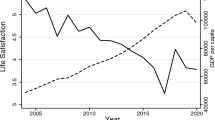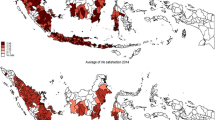Abstract
This paper investigates ten Asian nations to consider how socio-economic values affect happiness and satisfaction. Moreover, it considers whether economic factors can strongly affect wellbeing under certain conditions. Males in Asia are said they have more opportunities to obtain higher happiness and satisfaction but it does not happen in the current study. Unemployment has negative and significant impact with regard to happiness and satisfaction in developing countries yet it does not have the same effect in developed nations. It is believed cultural value positively affects happiness and satisfaction in East Asia but the result in the models is different with no clear relationship between this variable and wellbeing. Furthermore, some people declare that a relative increase of income compared to the lowest group will lead them to lower life satisfaction.
Similar content being viewed by others
Notes
We thank an anonymous referee for pointing out this fact.
References
Angeles, L. (2010). A closer look at the Easterlin paradox. The Journal of Socio-Economics,. doi:10.1016/j.socec.2010.06.017.
Becchetti, L., & Rossetti, F. (2009). When money does not buy happiness: The case of “frustrated achievers”. The Journal of Socio-Economics, 38, 159–167.
Bjorjlund, A. & Freeman, R. (2008). Searching for optimal inequality/incentives. NBER Working Paper No. 14014.
Blanchflower, D. G., & Oswald A. J. (2000). Well-being over time in Britain and the USA. Mimeo. Available at: http://www.dartmouth.edu/blnchr/papers/Wellbeingnew.pdf.
Bolle, F., Okhrin, Y. & Vogel, C. (2009). A note on interdependent happiness. The Journal of Socio-Economics, 38, 713–721.
Burman, B., & Margolin, G. (1992). Analysis of the association between marital relationships and health problems: An interactional perspective. Psychological Bulletin, 112(1), 39–63.
Chang, W. C. (2009). Social capital and subjective happiness in Taiwan. International Journal of Social Economics, 36(8), 844–868.
Chun, H., & Lee, I. (2001). Why do married men earn more: Productivity or marriage selection? Economic Inquiry, 39(2), 307–319.
Clark, A. E., & Oswald, A. J. (1994). Unhappiness and unemployment. Economic Journal, 104, 648–659.
Claudia, S. (2009). Direct evidence on income comparisons and their welfare effects. Journal of Economic Behavior & Organization, 72(2009), 408–424.
Diener, E., Suh, E. M., Lucas, R. E., & Smith, H. L. (1999). Subjective well-being: Three decades of progress. Psychological Bulletin, 125, 276–303.
Easterlin, R. A. (1974). Does economic growth improve the human lot? Some empirical evidence. In P. A. David & M. W. Reder (Eds.), Nations and households in economic growth: Essays in honour of Moses Abramovitz (pp. 89–125). New York: New York Academic Press.
Easterlin et al. (2010). The happiness-income paradox revisited. Proceedings of the National Academy of Sciences, December 13, 2010.
Frank, R. H. (1999). Luxury fever. Why money fails to satisfy in an era of excess. New York: Free Press.
Galbraith, J. K. (1958). The affluent society. Harmondsworth: Penguin Books.
Graham, C., Eggers, A., & Sukhtankar, S. (2004). Does happiness pay? An exploration based on panel data from Russia. Journal of Economic Behavior & Organization, 55(2004), 319–342.
Hilke B., Jan D., Christian W., & Hao Y. (2009). The China puzzle: Falling happiness in a rising economy. Journal of Happiness Studies 10, 387–405.
Inglehart, R. F. (1990). Culture shift in advanced industrial society. Princeton, NJ: Princeton University Press.
Inglehart, R., & Baker, W. E. (2000). Modernization, cultural change, and the persistence of traditional values. American Sociological Review, 65, 19–51.
Kenny, C. (1999). Does growth cause happiness or does happiness cause growth? Kyklos, 52(1), 3–26.
Leung, K. (2006). The rise of East Asia: Implications for research on cultural variations and globalization. Journal of International Management, 12(2), 235–241.
Loh, E. S. (1996). Productivity differences and the marriage wage premium for white males. Journal of Human Resources, 31(3), 566–589.
Peiro, A. (2006). Happiness, satisfaction and socio-economic conditions: Some international evidence. Journal of Socio-Economics, 35, 348–365.
Philip, O. (2007). Do dropouts drop out too soon? Wealth, health and happiness from compulsory schooling. Journal of Public Economics, 91(2007), 2213–2229.
Rafael, M., & Bustillo, L. (2005). Job satisfaction as an indicator of the quality of work. Journal of Socio-Economics, 34(2005), 656–673.
Ravallion, M., & Lokshin, M. (2000). Identifying welfare effects from subjective questions. Economica, 68, 335–357.
Ruprah, I. J., & Luengas, P. (2010). Monetary policy and happiness: Preferences over inflation and unemployment in Latin America. The Journal of Socio-Economics. doi:10.1016/j.socec.2010.08.001.
Scitovsky, T. (1976). The joyless economy: An inquiry into human satisfaction and dissatisfaction. Oxford: Oxford University Press.
Stutzer, A., & Frey, B. S. (2004). Does marriage make people happy, or do happy people get married? The Journal of Socio-Economics, 35(2006), 326–347.
Veenhoven, R. (1993). Happiness in nations: Subjective appreciation of life in 56 nations. 1946–1992. Rotterdam: Erasmus University Press.
Veenhoven, R. (1996). Developments in satisfaction research. Social Indicators Research, 37, 1–46.
Wilson, C. M., & Oswald, A. J. (2002). How does marriage affect physical and psychological health? A survey of the longitudinal Evidence. Mimeo: Warwick University.
Winkelmann, L., & Winkelmann, R. (1998). Why are the unemployed so unhappy? Evidence from panel data. Economica, 65, 1–15.
World Values Survey. (2010). Technical specifications of the values surveys. Accessed in October 2011. http://www.wvsevsdb.com/wvs/WVSTechnical.jsp.
Author information
Authors and Affiliations
Corresponding authors
Appendices
Appendix 1: Test Results
See Table 11.
Appendix 2: Explained Variables
V10. (Recoded) Taking all things together, would you say you are
-
1.
Not at all happy
-
2.
Not very happy
-
3.
Rather happy
-
4.
Very happy
V22. All things considered, how satisfied are you with your life as a whole these days?
-
1.
Completely dissatisfied … 10. Completely satisfied
V68. How satisfied are you with the financial situation of your household?
-
1.
Completely dissatisfied …10. Completely satisfied
V253. On this card is a scale of incomes on which 1 indicates the “lowest income decile” and 10 the “highest income decile” in your country. We would like to know in what group your household is. Please, specify the appropriate number, counting all wages, salaries, pensions and other incomes that come in.
-
1.
Lowest decile … 10. Highest decile
Appendix 3: Variables Definition
Age: Age of respondent in the surveyed year.
Age2: Age square.
Illness: Dichotomous variable that equals to 1 if the respondent declares a poor state of health, and 0 otherwise.
Female: Dichotomous variable that equals to 1 if the individual is female, and 0 otherwise.
1Child, 2children, 3children, >3children: Dichotomous variables that equal to 1 if the person has 1, 2, 3 or more than 3 children, respectively, and 0 otherwise.
Married, as married, divorced, separated, widowed: Dichotomous variables that equal to 1 if the individual is married, as married, divorced, separated or widowed respectively, and 0 otherwise.
LOCA2, LOCA3, LOCA4: Dichotomous variables that equal to 1 if the individual lives in a place whose population is combined of between 10,000 and 100,000, between 100,000 and 500,000, between 500,000 and more, respectively, and 0 otherwise.
Primary, secondary, university: Dichotomous variables that equal to 1 if the highest education level that the individual has attained is primary school, secondary school and university, respectively, and 0 otherwise.
Im-politics and im-religion: Dichotomous variables that equal to 1 if the individual’s politics and religion are important, and 0 otherwise.
Obedience: Dichotomous variable that equals to 1 if the individual teaches obedience to children, and 0 otherwise.
Work: Dichotomous variable that equals to 1 if the individual’s work is not important, and 0 otherwise.
Part-time, self-job, housewife, student, unemployed: Dichotomous variables that equal to 1 if the individual is part-time worker, self-job holder, housewife, student or unemployed, respectively, and 0 otherwise.
Income2, income3, income4, income5: Dichotomous variables that equal to 1 if the questioned person is in the second, third, fourth or fifth quintile of income, respectively, and 0 otherwise.
Data limitations: Size of town is not available for Japan, South Korea, China and Hong Kong. For Vietnam, the data with the size of population between 100,000 and more is not available. It is also not available for the size of town less than 10,000 people in Taiwan. Nevertheless, this variable is still added to the model for other nations because of useful interpretation. For education variable in Japan, the data of attendants at primary school is not available too.
Rights and permissions
About this article
Cite this article
Trung, N.N., Cheong, K., Nghi, P.T. et al. Relationship Between Socio-Economic Values and Wellbeing: An Overview Research in Asia. Soc Indic Res 111, 453–472 (2013). https://doi.org/10.1007/s11205-012-0014-z
Accepted:
Published:
Issue Date:
DOI: https://doi.org/10.1007/s11205-012-0014-z




